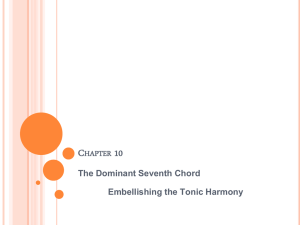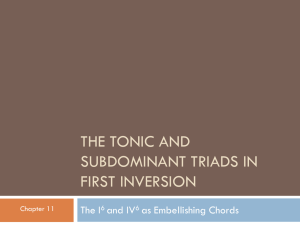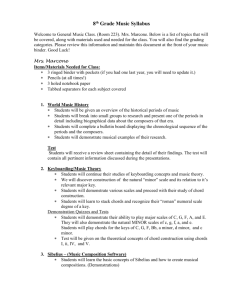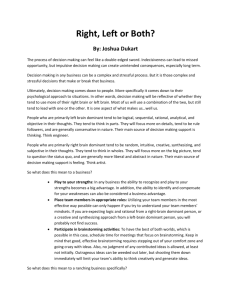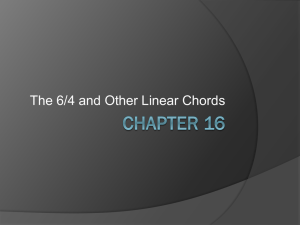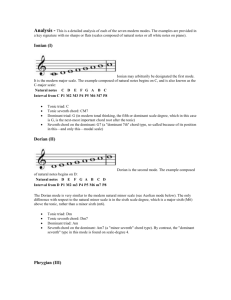Music 171 Assignment # 14 aka Final Exam part 1 50 Questions on
advertisement
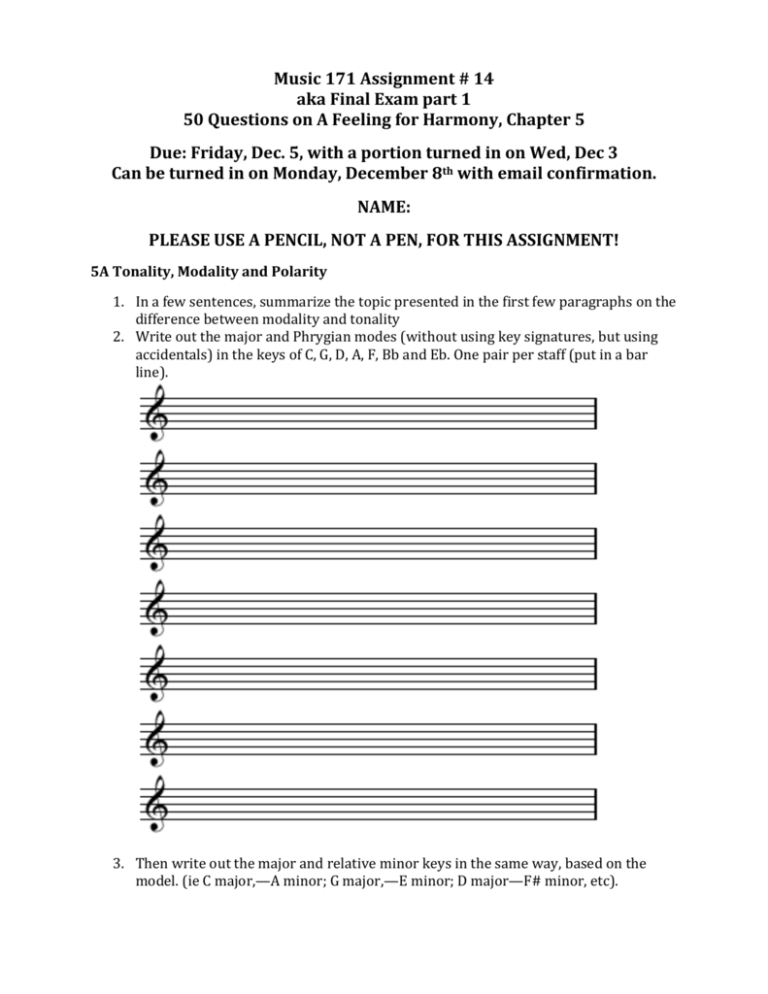
Music 171 Assignment # 14 aka Final Exam part 1 50 Questions on A Feeling for Harmony, Chapter 5 Due: Friday, Dec. 5, with a portion turned in on Wed, Dec 3 Can be turned in on Monday, December 8th with email confirmation. NAME: PLEASE USE A PENCIL, NOT A PEN, FOR THIS ASSIGNMENT! 5A Tonality, Modality and Polarity 1. In a few sentences, summarize the topic presented in the first few paragraphs on the difference between modality and tonality 2. Write out the major and Phrygian modes (without using key signatures, but using accidentals) in the keys of C, G, D, A, F, Bb and Eb. One pair per staff (put in a bar line). 3. Then write out the major and relative minor keys in the same way, based on the model. (ie C major,—A minor; G major,—E minor; D major—F# minor, etc). 4. Write out the combined harmonic and reciprocal series. What triad emerges from the 4-5-6 ratios in each series? 5. Copy out the Tonic, Dominant and Subdominant triads as presented in the next graphic, and then write these same chords in the keys of G, D, A, G, Bb and Eb major, using the proper key signatures. 6. Write out the following chords and circle the active tone. Use accidentals, not key signatures. a. Subdominant of C major b. c. d. e. f. g. h. i. j. k. l. m. Dominant of C major Tonic of C major Tonic of G major Tonic of F major Dominant of G major Dominant of D major Subdominant of E major Subdominant of F major Tonic of Eb major Dominant of Eb major Subdominant of E mjor Tonic of Bb major 7. Write out the following chords and circle the active tone. Use accidentals, not key signatures. a. Tonic of C minor b. Tonic of G minor c. Tonic of A minor d. Tonic of E minor e. Dominant of D minor f. Dominant of A minor g. Dominant of G minor h. Subdominant of C minor i. Subdominant of E minor 5B Key Signatures and the Cycle of Fifths 8. You all know your key signaures now, and the cycle of fifths, right? 5C Polar Harmonies 9. What are the two basic circular movements of tonal harmony? 10. Write out the central spine of expanded polarity. 11. Label these notes with both the Roman numeral symbols and the Function symbols. How do these two systems of labeling differ from one another? Does one method appeal to you or make more sense than the other? 12. Write out the chords above the central spine and label accordingly. 13. Summarize what was explained concerning Secondary Dominants and Secondary Subdominants. 14. How do you create a dominant seventh chord out of a dominant triad? 15. Write out the following chords as triads in root position, based on what you have studied: a. In C major: i. Dominant of the Dominant ii. Dominant seventh of the Dominant iii. Dominant of the Subdominant iv. Dominant seventh of the Subdominant v. Subdominant of the Subdominant b. In G major (you’ll need to transpose-think in the key of G) i. Dominant of the Dominant ii. Dominant seventh of the Dominant iii. Dominant of the Subdominant iv. Dominant seventh of the Subdominant v. Subdominant of the Subdominant c. In Relative Tonic in: i. C major ii. G major iii. D major iv. F major v. Bb major d. In C major i. I ii. V iii. V7 iv. V/V v. V7/V vi. bVII vii. V7/IV viii. Vi 5D Musical Examples 16. Write out the music for “Back in the Saddle Again”, just as it appears on the page. Include both the Function Symbols and the Roman numerals. 17. Study the chord progression for Hey Jude. Based on listening to the song, create barlines on these staves and write the chords in the proper place. Write the words underneath the measures. Keep in mind: Paul is singing in F major, I’ve transposed it to C major for purposes of understanding the harmonic progression. 18. Write out the chords for the closing section of Hey Jude (Na, na, na). Can you also write the melody? 5E Major and Minor Scales 19. Write out the C major scale and write in the names of the scale degrees. 20. Write out the A natural minor scale and write out the names of the scale degrees. 21. Write out the A minor melody presented on this page, to gain practice in using both the raised and natural leading tone. Be sure to listen to it again as you write it. 5F Singing with Solfege 22. Write a short paragraph describing the possible origins of the solfege system, including Western and Arab sources. 23. Write out the chromatic scale and include all the solfege syllables, both ascending and descending. 24. Describe the two methods for singing minor melodies using solfege. Do you think one method is better than the other? If so, why? 25. Can you sing this melody along with the sound file, using the solfege syllables? If not, is this something you can imagine being able to do by the end of the semester? If not, and that’s OK!, why do you think it’s difficult? 5G Building Triads on Scale Degrees 26. Write out the seven triads in the key of C, and label them with their scale degree names and their Roman numeral designations. 27. Which three chords are major? Which three chords are minor? Which chord is diminished? What does it mean that this chord is a diminished triad—what is its distinguishing feature compared to the other six triads of the scale? 28. Give the Function names for the following chords: a. I b. IV c. V d. vi e. ii f. iii 5H Deeper Meaning of Harmonic Polarity This page is not yet complete, but I can ask two questions that are pertinent: 29. What does Harmonic Polarity have to say about out experience of major and minor tonality? How does Goethe, who was a philosophy, not a musician, support the principle of Harmonic Polarity. 30. Read the section on “Listening from Above” and summarize the issues involved with this topic. 5I More on Dominant Seventh Chords 31. Describe how the Dominant seventh chord is formed according to both conventional theory and Polarity Theory. 32. What is the distinguishing feature of the dominant seventh chord, and why does this chord have a sense of forward motion toward the root and third of the key? 33. Copy out the two cycle of fifths progressions exactly as they appear on the page. Notice, as you are writing, how the tritone resolves in alternating patterns of “inward” and “outward.” Be sure to listen to the sound file while you are doing this, in order for the sound to get into your ears. Example 1 here, example 2 on the next page. Ex 34. Copy out the pattern under Secondary Dominants—using V7/IV and V7/V. Listen to it while you do so. Then try to transpose this to the key of G and the key of F major, using the proper key signature for each. 35. Copy out the pattern for “Using V7/vi and V7/iii (movement to minor triads). Listen to it while you do so. Then try to transpose this to the key of G major and F major, using the proper key signature for each. 5J Major, Minor and Diminished Seventh Chords 36. Copy out the three minor seventh chords and the two major seventh chords in the key of C, as presented on this page. 37. Write out the same chords, transposing them to the key of G and the of F major, using the proper key signature. 38. What is the relationship between the Dominant seventh chord and the diminished triad in the key of C major? Why do we say that both of these chords resolve the same way? 39. Copy out the patterns under the heading “The Diminished Seventh Chord.” See if you can transpose these to the keys of G and F major. 5K More on Major and Minor Harmony 40. Write out the harmonic and melodic minor scale in the key of C minor. 41. Using the proper key signatures, write out the same two scales in the keys of D minor, E minor, B minor and G minor. 42. Copy out the third graphic under the title “harmony in natural minor,” including the labels above and below the chords. What is the essential point being made by this graphic. 43. What essential harmony is used in a minor key that comes from the harmonic minor scale? 44. Write out the key signatures for C minor, D minor, E minor, B minor, G minor and A minor, creating three measures for each system. After each key signature, write out the chord progression i V i , as shown in the third measure of the “Harmony using the Harmonic Minor Scale” section. Be sure to raise the leading tone of the dominant chord in each case. 45. Tell me something about the nature of the subdominant chord in both the major and the minor keys. What does it sound like when it shifts modes like this (listen to it and have a response). 46. Jazz tunes. Copy out the chart for “Softly as in a Morning Sunrise” exactly as it appears on the page, with the chord symbols and Roman numerals. What does it sound like when the middle part of the tune appears, with the change from C minor to Eb major? 47. Tell someone who knows a little something about music about the tune “Autumn Leaves.” How is it basically configured? 5L The Blues 48. Write out the blues scale (C Eb F F# G Bb C) and then transpose it to the following keys: G, F, D and Bb. Make sure you create the same intervals between the notes. 49. Write out a 12-bar blues progression in the keys of C (given), G, F, D, Bb, A and Eb. Use this model C7 | C7 | C7 | C7 || F7 | F7 | C7 | C7 || G7 | F7 | C7 | G7 ||| G: F: D: Bb: A: Eb: 50. What is it in the notes of the blues scale that creates the tension against the notes of the harmony?

